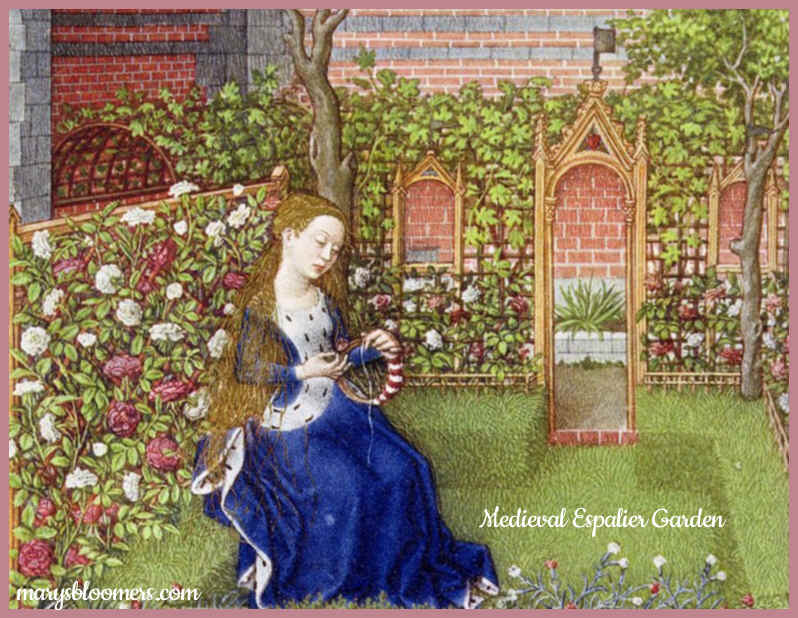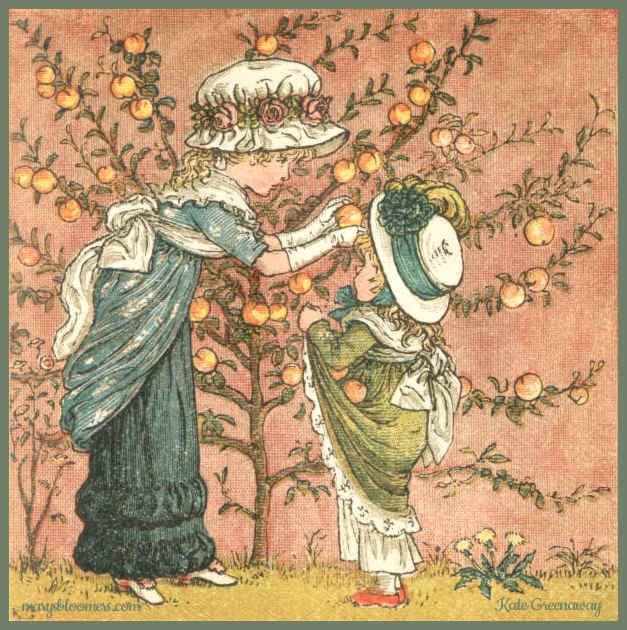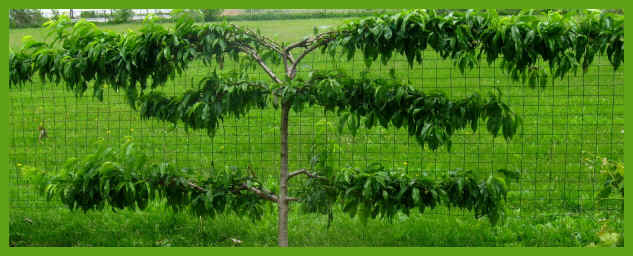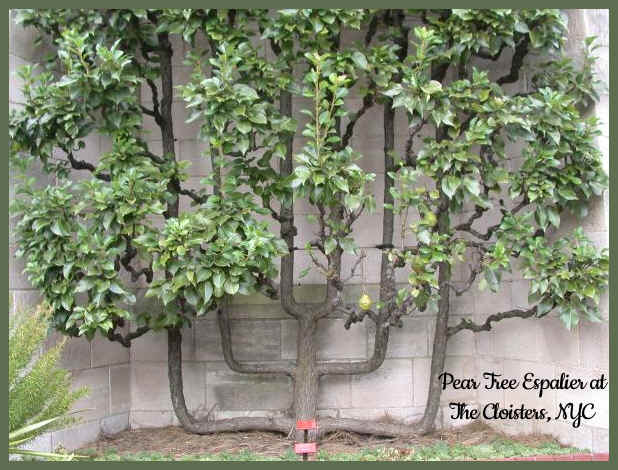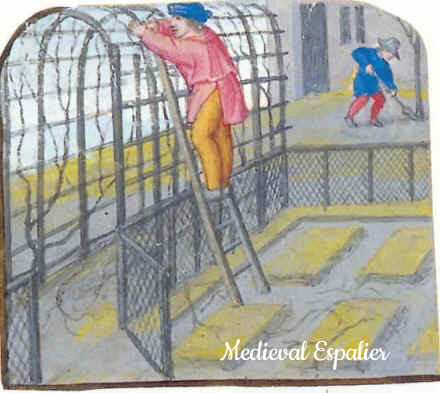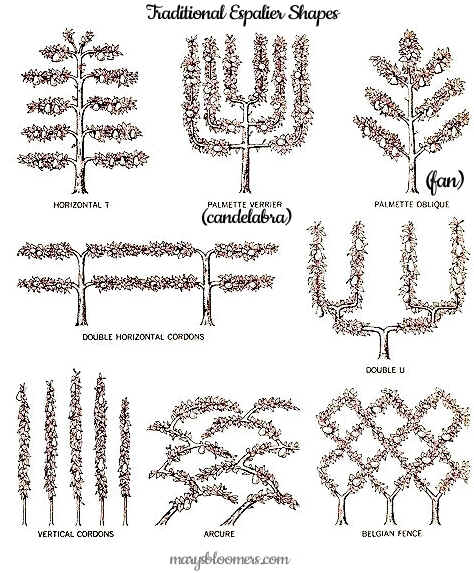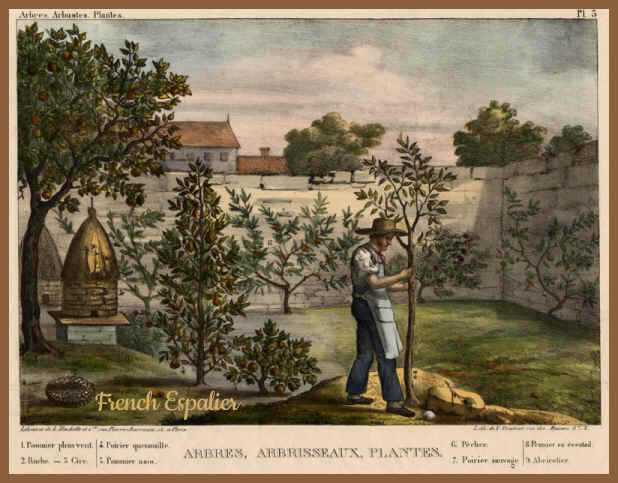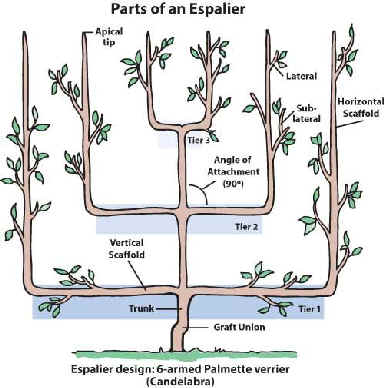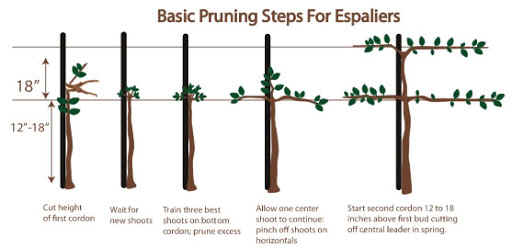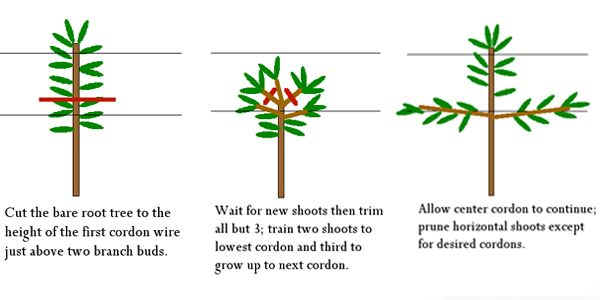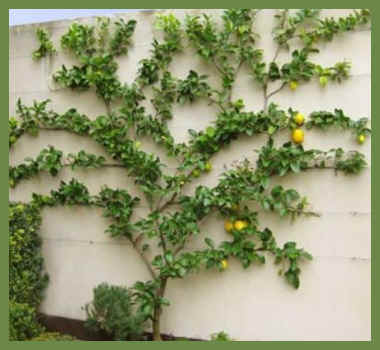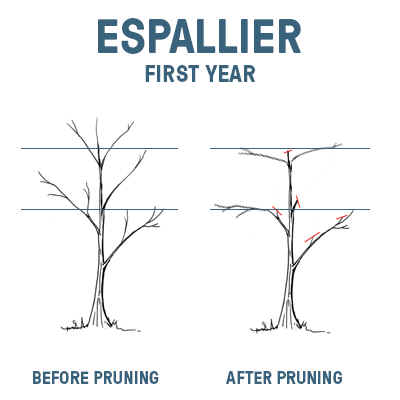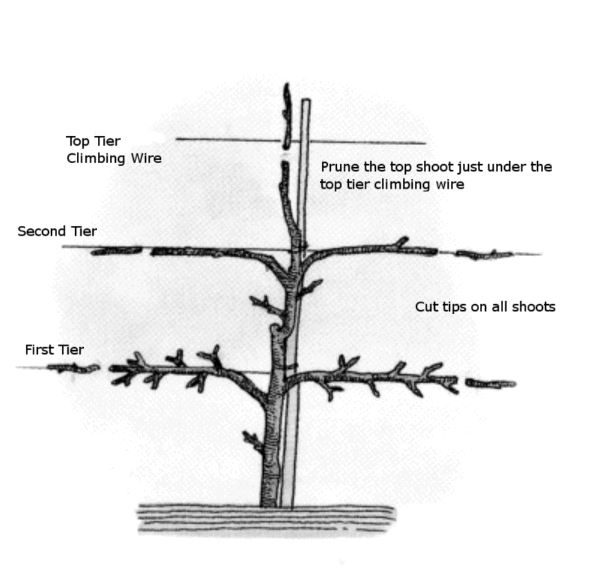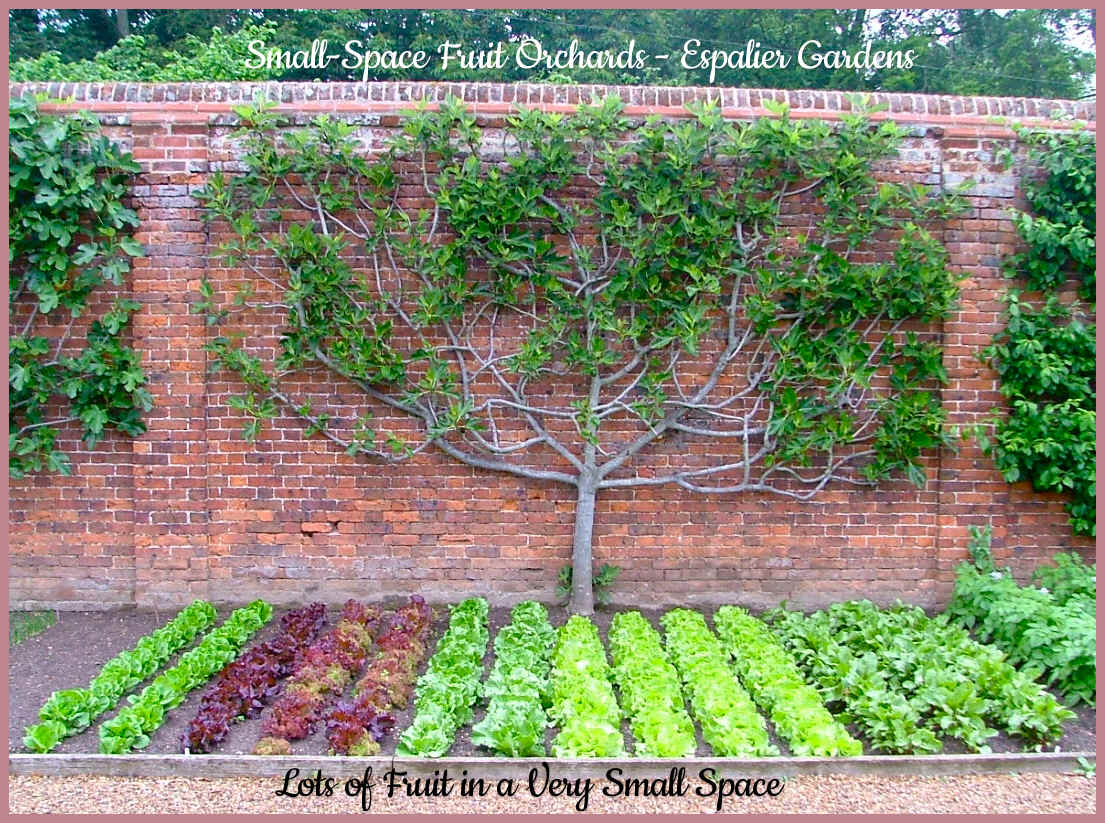 |
| Photo:
Wolterton and Mannington Estate, Norfolk, England
Espalier (ess-PAL-yay) gardening is
the ancient horticultural art of training trees, vines and shrubs to
grow into a 2-dimensional pattern against and along a trellis, fence or
solid wall. The word espalier is French, and it comes from the Italian spalliera, meaning "something to rest the shoulder (spalla) against." During the 17th Century, the word initially referred only to the actual trellis or frame on which such a plant was trained to grow, but over time, it has come to be used to describe both the practice and the plants themselves. Plants are frequently shaped in formal patterns, flat against a structure such as a wall, fence, or trellis. According to American Garden History, espalier was originally used to create outdoor "walls" in Europe during the Middle Ages, and was also planted in interior courtyard walls to prevent late spring frost bud-kill. The practice also allowed the cloistered residents of warring cities to feed themselves without venturing beyond the safety of their walled compounds. Other records show this technique dates back to ancient Egypt, where hieroglyphs of espaliered fig trees have been found in tombs dating back to 1400 B.C.
Espalier are ideally suited to small
spaces. Perfect for terrace gardens and courtyards. I like to call it a
horizontal fruit garden design. If you don't have a fence, you can still grow an espalier row that will also serve as a boundary around your property. When it fills in, it's a living fence. Dwarf fruit trees produce full-sized fruit on a dwarf rootstock. With an espalier, you can harvest your fruit quickly and easily, and nothing will be wasted or eaten by birds because you have a 25 ft. tree. You will get fruit in much less time, need much less time pruning to control its size, and be better able to protect your fruit from birds and animals when you're using dwarf varieties of trees. There's a dwarf or semi-dwarf variety of almost every fruit. There are also structures you can buy, trellises and tunnel forms, that can be used to train trees against and put them wherever you want.
Planning Your Espalier Garden Espalier are trained to grow against a frame or flat wall having only two dimensions – width and height. Apart from the obvious visual attraction there are three good reasons to find a suitable espalier pattern for your plants :
Some gardeners enjoy growing espaliers that produce
fruit because you can get a lot of fruit trees without a lot of space, but
you can choose ornamental tree species as well. Choose plants that will
branch and spread naturally and that are well-suited to the growing
conditions of your location. Walls and Fences - Most espalier is done on wood fences, because you can screw the shaping wiring in and not damage a vinyl fence. But you can work around that, and you can have free-standing espaliers that are grown close to the fence. Or grow them along a wall, by putting screws or eyehooks into stone, siding, brick, stucco, or wood structures. If you have a vintage metal wire fence, you won't need to make wires to train the trees. Just attach and prune your branches using the openings as the backbone of your design.
Espaliers can be used to disguise unattractive walls or
fences or to screen views ugly areas. Free-standing forms make elegant
fences or unique vertical accents. The intensive pruning directs energy away from vigorous vertical growth into the shorter, lateral fruit-bearing spurs, resulting in heavier yields than on ordinary trees. Because they are less susceptible to breaking branches, espaliered trees can have an incredible life span – some espaliered apple trees are still producing fruit after 150 years. Some other advantages to espaliering fruit trees include being able to grow several different cultivars in the space of a single normal tree, for greater diversity in fruit types and cross-pollination requirements; the trees bear earlier and for a longer time with deeper fruit color.
What To Plant Use almost any woody tree or tall shrub. The branches and stems will be stronger and more bendable, and won't break as easily as fibrous stems. While designing a tree presents a challenge, you can take a shortcut by purchasing espalier starts at a nursery. Already shaped and trained on trellising, these can be planted in a chosen spot and their forms simply extended and maintained as they develop. Apple and pear trees are the traditional espalier subject. because they have supple, easily-trained new growth, but other fruit trees that sometimes are espaliered include fig (Ficus carica), peaches, cherries and pomegranates. Plums, nectarines and apricots require more careful pruning. Dwarf cultivars are easier to train than standard size trees. Almost any woody plant with long flexible branches can be used for espalier. Ornamental plants such as bougainvillea, camellias, cotoneaster, flowering crabapples (Malus), flowering quince, forsythia, holly, magnolia, Pfitzer juniper (Juniperus chinensis ‘Pfitzerana’), some viburnums, winged euonymous, and witch hazels (Hamamelis) are quite amenable to espalier. Climbing roses could be used, because their natural climbing habit is easy to manipulate.
When planting, place each tree about 6-12 inches from the wall or fence, with its two strongest shoots or branches situated to follow your design. Take your time to ensure your plants are spaced precisely the same distance apart. The best types of plants are established, and about 3-4 ft. tall, or 3+ gallon size, because these will be strong already and take more kindly to constant pruning. When branches are about a foot long, tie them loosely to wires or eyebolts using twine or another material that won't dig into soft stem tissue. Prune annually, in late winter or early spring, before active growing starts. You can also espalier potted fruit trees. They'll be a little further from the support, but you don't have to plant the trees in the ground. That's my ideal scenario. I have some tall pots with flat sides that will work better than round ones. |
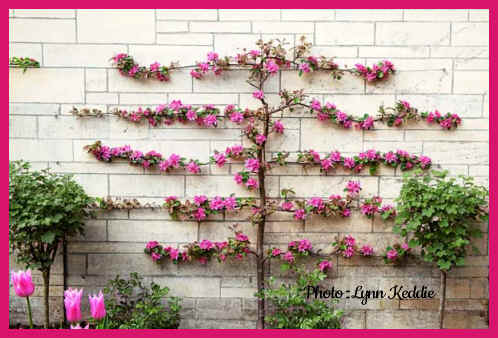 |
| Pattern
Based on your chosen design, string heavy-gauge wire between nails inserted in the wall or fence or through notches cut into the fence panels. As a general rule fruits that have stones (such as cherries, mirabelles, peaches, plums, nectarines, apricots, cherries) are best trained as fan patterns. One of the simplest and most effective ways to train a fruit tree is as a U Cordon, sometimes called "Candelabra".
Training and Maintaining When to Prune You may need to prune two or three times per season to keep the tree in shape. The first pruning should be after it blooms in the spring. The flowers will indicate where the fruit will be, and you can prune accordingly. Any major pruning needed is generally accomplished while the plant is dormant.The bending and training of the limbs that will remain in the design is done during the progression of the summer season, when they are most flexible. While it usually takes about four years to get the full artistic effect of your efforts, you may actually see fruit as soon as the second year. Especially when growing dwarfs, and if you planted a good-sized tree, not just a cutting. The dwarfs will bear fruit much sooner.
|
|
|
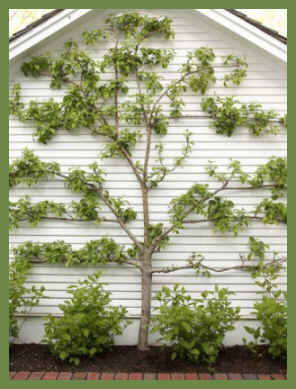 |
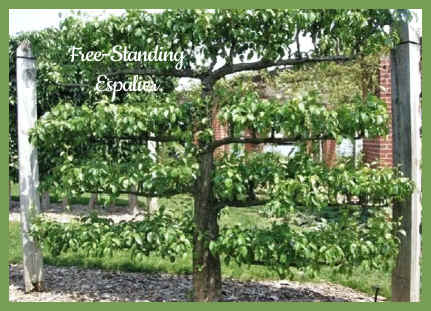 |
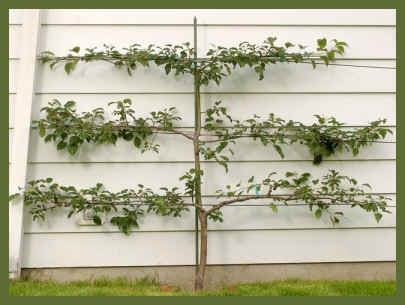 |
|
You can add several rows of wire or support for height, if you wish. I would keep mine at 5-6 feet tall for ease of care. Unless i want to use a ladder. Which I don't. Plant a fruit or ornamental flowering tree in the middle. Cut out dead, damaged and diseased wood.Select the branches that will form your espalier. Branching should start well below the wire so that you don't damage them when you tie them on the wire. Prune out all other branches. When branches are pulled below 45° growth slows down. You can use this fact to ensure that branches grow evenly by pulling down longer branches first and leaving smaller ones to grow. |
Fence or trellis panels with squares means
no need for many training wires, and flexibility in design.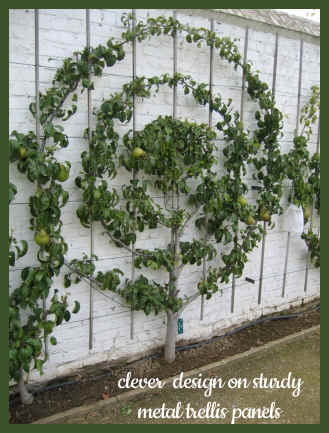 |
Just prune and attach branches
to the trellis as you go along, for the design you want. This type
of trellising will add an asian or zen feel to the garden design. The
squares are just begging for something decorative to be placed into the
design.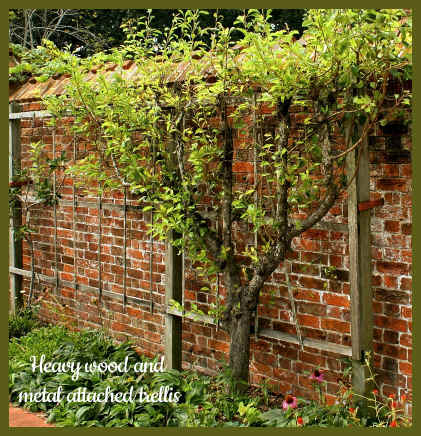 |
|
Your design and plant species will determine your
specific pruning and training approach; however, the basic steps are the
same no matter what design you select. |
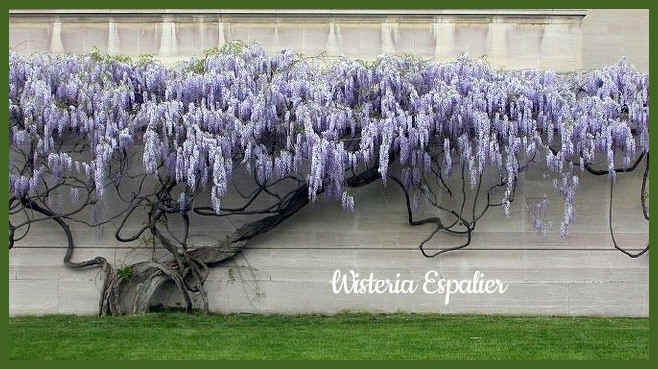 |
Information Sources
Stark Bros. Nursery
Wikipedia
The Enduring Gardener
This Old House
University of Wisconsin
If you love vintage graphics like the ones displayed on this page, check out dozens of our digital art collections
Quick Links
Content, graphics and design ©2021 marysbloomers.com
